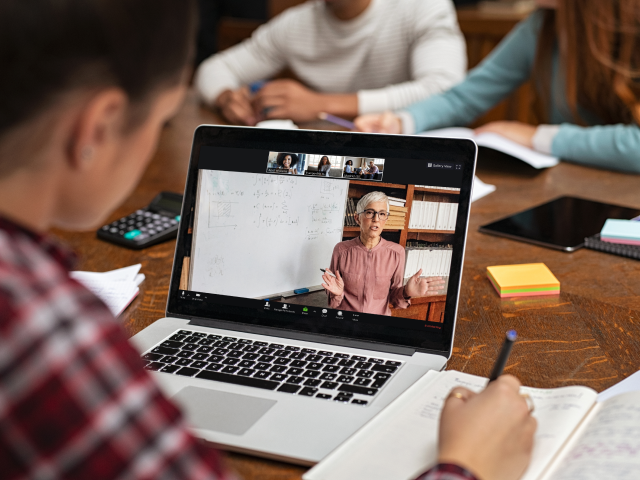Find out what today’s education leaders in APAC have learned about collaborating with students and stakeholders.

- 01 Cloud-based technology boosting collaboration in education - Jumplink to Cloud-based technology boosting collaboration in education
- 02 Parent-teacher collaboration is key - Jumplink to Parent-teacher collaboration is key
- 03 Teacher collaboration drives lesson quality - Jumplink to Teacher collaboration drives lesson quality
- 04 Global collaboration expands educational opportunities - Jumplink to Global collaboration expands educational opportunities
- 05 It takes a village - Jumplink to It takes a village
The pandemic changed the world in countless ways. For the education sector, it opened the door to a digital transformation that the industry as a whole had been putting off for years.
From January to March 2022, IBRS conducted a series of case study interviews with primary, secondary and tertiary institutions from the ANZ and ASEAN region to get a deeper understanding of the pandemic’s effect on education as a whole. While many issues and ideas were raised in the resulting report, increased collaboration was a key theme throughout.
It seems that while the pandemic forced us to embrace short-term, band-aid solutions for lesson delivery, it also changed the entire educational landscape on a deeper level. It accelerated the adoption of technology, which changed the way educators, parents, and students approach the learning process.
The importance of the home-school relationship is well-known. In lockdowns, the role of parents in education became one of the most important factors for K-12 education. Parents were thrust into the role of unpaid teaching assistants, often while attempting to perform their salaried jobs.
Some schools used this time as an opportunity to educate parents through online support programs, promoting sound educational practices and video call engagements to answer questions. In general, these schools leveraged existing investments in their LMS and collaboration platforms to engage with parents. The challenge was not the technology or communications channels, but developing content and programs that would meet the needs of time-poor and stressed parents.
The upshot of this forced home-school connectivity was a significant increase in parent-teacher engagement. This engagement looks to be surviving after the lockdowns, though it may change over time. The lesson here is that schools have a window of opportunity to set new expectations and standards for the role parents play in their children’s education.
You know, the old saying that it takes a whole community to teach one child, right? This is that era… we need to put into place feedback mechanisms with parents and students, and the academic community.
Joseph Ray Garrido, La Salle Green Hills
One of the few benefits from the events of 2020-21 was the rapid update of collaboration platforms by educators, not just to engage with students remotely, but increasingly to engage with their peers for the sharing of better practices and the creation of learning content. This marks a significant shift in the collegiality of education. Educators’ use of learning management solutions has matured significantly. A great deal of analogue learning content was rapidly digitised into learning management solutions, but also shared and reviewed between peers.
The peer review process, while generally informal in many institutions, is likely to become embedded into future operations. By allowing the constant sharing of ideas and prompting discussions on better practices, collaboration strengthens adherence to learning frameworks and pedagogy while also saving resources for teachers.
This evolution in content development will result in highly granular, bite-sized, educational content that can be reused across multiple curricula and upgraded frequently. Breaking learning content into smaller, singularly focused items is highly attractive to secondary and tertiary students, since it allows them to cherry-pick the content that resonates best with them at any given point in their own learning journey. In short, it allows for true student-directed learning.
The lockdowns demonstrated that both students and teachers could be effective when engaged remotely. While most attention has been paid on remote learning, some institutions now recognise that remote teaching may open new avenues for expanding their educational offerings, enhancing the quality of teachers through specialisation, or even just attracting teachers for remote teaching.
Through the power of technology, a teacher with niche or specialised knowledge can connect with students from anywhere in the world, whether the students themselves are in a classroom or learning remotely.
I’m now able to bring all the experts in technology, public health, marketing, and advertising, and music directly into a school setting via video. Previously, it was very difficult and costly to bring subject-matter experts and practitioners into the school to help students decide their areas of interest and careers. Now, with the new economics and expectations, we can do more of this. For example, I just recently introduced a course in quantum computing and I have 30-plus students in that program. That would not have been possible in the past.
Joseph Ray Garrido, La Salle Green Hills
Remote teaching also removes many logistical challenges and has the potential to reduce geography-based education disparities in future.
Staffing, particularly in some subject areas, in regional Australia, is very challenging. Remote teaching could help alleviate this teacher shortage. We currently have teachers teaching across South Australia and Western Australia, but challenges with state-based registration and real-remote teaching potentially disrupts that policy. Technically, we could have teachers teaching anywhere across the country or even the world.
Carolyn Rhodes, OneSchool Global
Although it was largely available prior to the pandemic, the rapid rise in the use of digital technology among educational institutions has opened the door for extensive collaboration. Utilised well, national or even global collaboration could reduce costs, save time, improve outcomes, and reduce educational inequalities. So, whether it be parents, teachers, students, administrators, curriculum designers, or policy makers, all stakeholders now have the ability and — responsibility — to embrace the opportunities afforded by this ongoing digital revolution.
IBRS’ research, while sponsored by Zoom, was conducted independently and does not focus on Zoom’s solutions. To read the full IBRS report, click here.